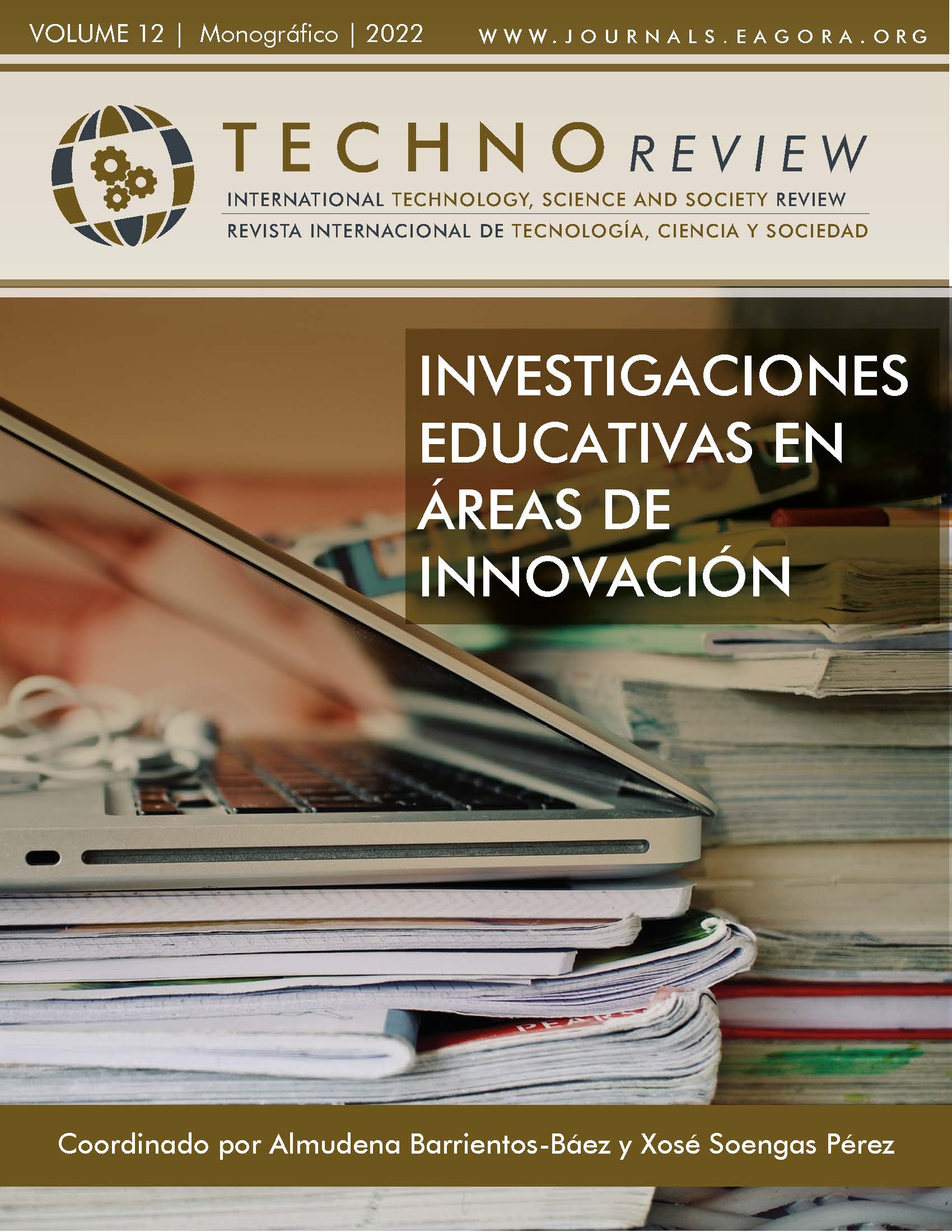Experience of dog-assisted education as a pedagogical tool in university classrooms
DOI:
https://doi.org/10.37467/revtechno.v11.4423Keywords:
Dog-assisted education, University students, Well-being, Attention, StressAbstract
This research has been carried out with the presence of an Assisted Education dog in a university classroom for five sessions in 2021. The objective is to study the benefits it has on the working environment (reduction of stress) by increasing attention, concentration and level of participation.
The methodology is descriptive. Two surveys were carried out (initial and final) based on theory with quantitative items, according to the Likert scale, and qualitative items. The results obtained reflect a decrease in stress, a benefit in the work environment, and an increase in attention.
References
Adams, N. (2009). Animal Assisted Interventions for Adolescents with Emotional and Behavioural Problems. School of Psyhology, Psychiatry and Psychological Medicine, Monash University. http://www.lerenmethonden.nl/links/Naomi%20Adams%20AAT%20Lit%20Review.pdf
Allen, K., Blascovich, J., Tomaka, J., & Kelsey, R. (1991). Presence of human friends and pet dogs as moderators of autonomic responses to stress in women. Journal of Personality and Social Psychology, 61(4), 582-589. DOI: https://doi.org/10.1037/0022-3514.61.4.582
Allen, K., Shykoff, B. E., & Izzo Jr, J. L. (2001). Pet ownership, but not ACE inhibitor therapy, blunts home blood pressure responses to mental stress. Hypertension, 38(4), 815-820. https://doi.org/10.1161/hyp.38.4.815 DOI: https://doi.org/10.1161/hyp.38.4.815
Beck, A. M. (1997). La relación de las personas mayores con los animales: compañía, salud y calidad de
vida. En Animales de compañía, fuente de salud: comunicaciones III Congreso Internacional (pp. 17-32). Fundación Purina.
Beck, K. R., (2015). El impacto de la terapia asistida por perros y las actividades en los niños en un entorno educativo. Educación Maestros Paper 312. https://fisherpub.sjfc.edu/education_ETD_masters/312/
Campos, A. (2010). Neuroeducación: uniendo las neurociencias y la educación en la búsqueda del desarrollo humano. La Educación, 143. https://hdl.handle.net/11537/25280
Castro Pérez, M., & Morales Ramírez, M. E. (2015). Los ambientes de aula que promueven el aprendizaje, desde la perspectiva de los niños y niñas escolares. Revista electrónica Educare, 19(3). https://www.redalyc.org/articulo.oa?id=194140994008 DOI: https://doi.org/10.15359/ree.19-3.11
Chandler, C. (2001). Animal assisted therapy in counseling and school settings. ERIC Digest. https://eric.ed.gov/?id=ED459404
Cusack, O. (1991). Animales de Compañia y Salud Mental. Fundación Purina. https://sid-inico.usal.es/documentacion/animales-de-compania-y-salud-mental/ Dotti J. (2005). Terapia y Animales. Paco Editorial.
Extremera, N., & Fernández-Berrocal, P. (2004). El papel de la inteligencia emocional en el alumnado: evidencias empíricas. Revista Electrónica de Investigación Educativa, 6(2). https://www.redalyc.org/articulo.oa?id=15506205
Fine, A. H. (2010). Handbook on Animal-Assisted Therapy. Theoretical Foundations and Guidelines for Practice. Academic Press, https://doi.org/10.1016/c2009-0-01976-x DOI: https://doi.org/10.1016/C2009-0-01976-X
Fine, A. H. (2014). Our faithful companions: Exploring the essence of our kinship with animals. Alpine Publications.
Fundación Purina (1999). Animales de compañía, fuente de salud. Fundación Purina, p. 152
Hodson, D. (1987). Social control as a factor in science curriculum change. Internacional Journal of Science Education, 9(5), 529-540. https://doi.org/10.1080/0950069870090503 DOI: https://doi.org/10.1080/0950069870090503
IAHAIO (2018). International Association of Human-Animal Interaction Organizations. The IAHAIO definitions for animal assisted intervention and animal assisted activity and guidelines for wellness of animals involved. https://iahaio.org/wp/wp-content/uploads/2018/04/iahaio_wp_updated-2018-final.pdf
Iacoviello, M. (2018). Potencial de las intervenciones asistidas con perros en las políticas públicas de bienestar animal. En M. Díaz Videla, M. & M. A. Olarte (Eds.), Antrozoología, Multidisciplinario campo de investigación
(pp. 134-157). Akadia.
Jacobsen, J.J. (1997). Pet Therapy: A study of the use of companion animals in select therapies. Pikes Peak. Keller, S. R., & Wilson, E. O. (1999). The Biophilia Hypothesis. Island Press. https://doi.org/10.1177/027046769501500125 DOI: https://doi.org/10.1177/027046769501500125
John-Tyler Binfet, Freya L. L. Green & Zakary A. Draper (2021). The Importance of Client–Canine Contact in Canine-Assisted Interventions: A Randomized Controlled Trial. Anthrozoös, DOI: 10.1080/08927936.2021.1944558 DOI: https://doi.org/10.1080/08927936.2021.1944558
Kruger, K. A., y Serpell, J. A. (2010). Animal-assisted interventions in mental health: definitions and theoretical foundations. En A. H. Fine (Ed.) Handbook on animal-assisted therapy. Theoretical foundations and guidelines for practice (pp. 33–48). Academic Press. http://dx.doi. org/10.1016/B978-0-12-381453- 1.10003-0 DOI: https://doi.org/10.1016/B978-0-12-381453-1.10003-0
López, J., & Borrego, C. (2019). Animales de compañía y salud. Del vínculo humano- animal al diseño de intervenciones asistidas por animales. Pirámide.
Martínez Abellán, R. (2008). La terapia asistida por animales: una nueva perspectiva y línea de investigación en la atención a la diversidad. Indivisa: Boletín de estudios e investigación, 9, 117-146. https://www.redalyc.org/pdf/771/77100909.pdf DOI: https://doi.org/10.37382/indivisa.vi9.331
Mercer, S. (2019). School-based dogs, their use and effectiveness: a phenomenological study. The STeP journal, 6(1) 38-58. file:///C:/Users/j/Desktop/administrator,+Mercer.pdf
Nimer, J., & Lundahl, B. (2007). Animal-assisted therapy: A meta-analysis. Anthrozoös, 20(3), 225–238. https://doi.org/10.2752/089279307X224773 DOI: https://doi.org/10.2752/089279307X224773
Ortiz Jiménez, X., Landero Hernandez, R., & Gonzáles Ramírez, M. (2010). Terapia asistida por perros en el tratamiento del manejo de las emociones en adolescentes. Summa Psicológica, 9, (2), 25-32. DOI:10.18774/448x.2012.9.95 DOI: https://doi.org/10.18774/448x.2012.9.95
Real Academia Española. (2019). Diccionario. https://dle.rae.es/
Rossbach KA, & Wilson JP (1992). Does a Dog’s Presence Make a Person Appear More Likable?: Two Studies.
Anthrozoos, 5(1), 40–51. doi:10.2752/089279392787011593 DOI: https://doi.org/10.2752/089279392787011593
Smith, B. P., & Dale, A. A. (2016). Integrating animals in the classroom: The attitudes and experiences of Australian school teachers toward animal-assisted interventions for children with Autism Spectrum Disorder. Pet Behaviour Science, (1), 13-22. DOI: https://doi.org/10.21071/pbs.v0i1.3994 DOI: https://doi.org/10.21071/pbs.v0i1.3994
Stone, B. (2010). Cockapoos in the classroom: Providing unique learning opportunities for children with autism.
Exceptional Parent, 24-25. https://eric.ed.gov/?id=EJ890067
Souter MA, Miller MD. (2007). Do animal-assisted activities effectively treat depression: a meta- analysis. Anthrozoos 20(2), 167-180. https://doi.org/10.2752/175303707X207954 DOI: https://doi.org/10.2752/175303707X207954
Downloads
Published
How to Cite
Issue
Section
License
Those authors who publish in this journal accept the following terms:
- Authors will keep the moral right of the work and they will transfer the commercial rights.
- After 1 year from publication, the work shall thereafter be open access online on our website, but will retain copyright.
- In the event that the authors wish to assign an Creative Commons (CC) license, they may request it by writing to publishing@eagora.org








